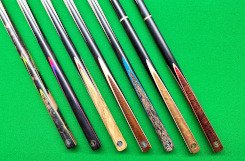The history of billiards
Billiards has been around for hundreds of years and is believed to be the original table game that led to many variations including snooker and pool. Ironically as snooker and pool became more popular, billiards became less of a popular game even though it is still played by many great players. So where did this game all start?
You need to go back to the 1500’s when many lawn games were being played in Europe and the UK. These games were played by all classes of people including gentry, royals right down to the common “peasants”. The most well known lawn game that we still recognise is croquet where a ball is guided through hoops by the means of a wooden mallet. Golf was also being played at this time, so billiards seems to be a cross between these two games. Billiards was also played outside originally, it was at this stage a very basic game, played on a lawn with maces and boundaries were often set by the use of river banks etc. As Europe and the UK are not well known for great weather a version of billiards was played indoors allowing players to enjoy the game all year round. This is one reason why the cloths on the original billiard tables were green, a replication of a lawn area!
There are many references from the past that depict the game of billiards, it is included in many sources of medieval art showing how popular this game was.
The original tables did not have pockets, cues were not used but the ball was pushed by sticks referred to as maces rather than the ball being struck in a clean shot provided by cues. The “banks” of the table were solid hence no such thing as cushion shots.
Cues were not introduced until the 1600’s, this came about as shots were clumsy when the object ball rested on the banks as the maces were not slender enough to allow full access to the ball. The mace would be turned around for these shots so the tail of the stick would be used, the French word for tail is queue and over the years the word “cue” evolved and is still used to this day.
The original billiard tables comprised of the green felt surface and solid rails all of the way around. The rails served one purpose, to keep the balls on the table. One version of the original game involved adding obstacles to the table, this was usually a hoop and a small wooden pyramid referred to as a “king”. The object was to guide the ball through the hoop but avoid knocking over the king.
Over time pockets were added to the table, these pockets were originally known as “hazards”, this derived from the hazards on a golf course. Some versions of the game did not require pockets at all and the table remained the same. It was also noticed over time that the ball could be made to bounce of the solid rails when the ball was struck against them. This is where the term “bank shot” originates from. I time the rails were covered and stuffed with material to allow more of a bounce enabling much better return from the ball, hence the name for these as “cushions”.
It wasn’t until the 1800’s that the game developed into it’s greatest heights and formal rules were introduced which standardised the game. Snooker tables have always been rectangular but dimensions were provided for the correct size of table which at the time was 10 feet by 5 feet (300 cm x 150 cm). Snooker tables are usually made to 12 feet by 6 feet (360 cm x 180 cm) and this size is acceptable for billiards as well. Slate was started to be used for the bed of the table and once rubber became more widely available this was used in the cushions to provide a greater bounce of the ball.
Cues began to develop and instead of striking the object ball with the wooden tip, leather tips were added and the use of chalk to provide more friction was becoming very popular. Even the number of pockets on the table used to vary, some tables only had 4 pockets but now it is standard for every table to have a pocket in each corner and a pocket one each side halfway down the table.
Of course as with most games there were still variations on the basic game and this was mostly dependant on the country that the game was being played. English billiards comprised of the use of 3 balls i.e. two object balls and a red ball. In the USA 4 ball billiards emerged where the tables only had 4 corner pockets and there were two red balls in play alongside the two object balls.
It was in 1870 that the first billiards championship was held in England and by this time Queen Victoria was also adding billiard table to her residences, she even had heated tables to keep the cushions at their best during the colder months. The heated cushions was also adopted by some manufacturers in their tables and they are still available to this date if required.
As mentioned above, billiards was the father to such games as snooker and pool but this had the effect of decreasing its popularity as the new games took over. It wasn’t until the 1960’s that a resurgence of popularity occurred when the film “The Hustler” was released starring Paul Newman. This film received a great audience and it highlighted the game of billiards to its best giving the game a second burst of energy.
Over its lifetime that have been many famous people who played this game, these include Abraham Lincoln, William Shakespeare, King Louis XIII and the great composer Mozart.
In many historical publications billiards gets a mention and wood carvings depict the game in its various forms making a fascinating insight into the history of this game.

